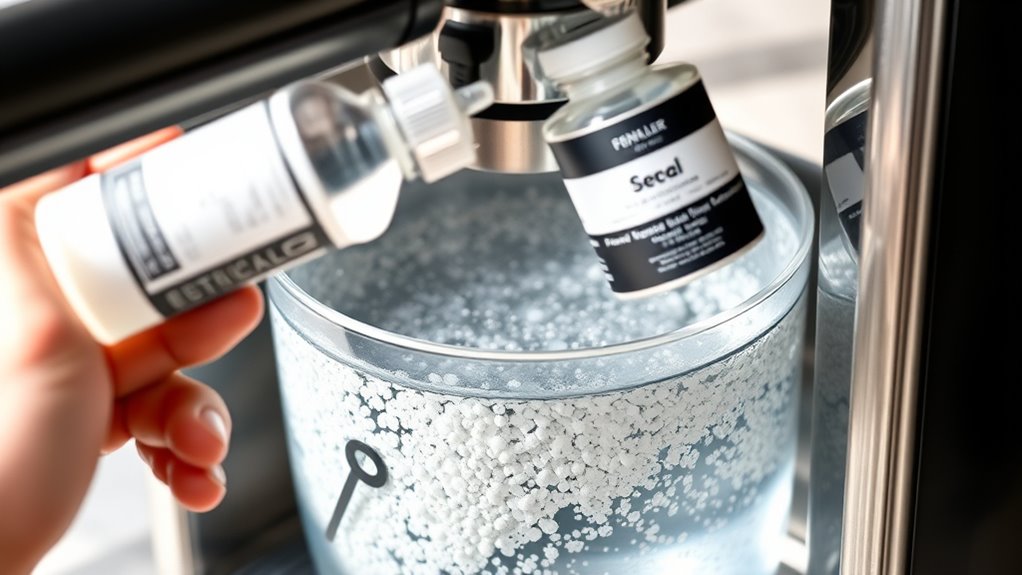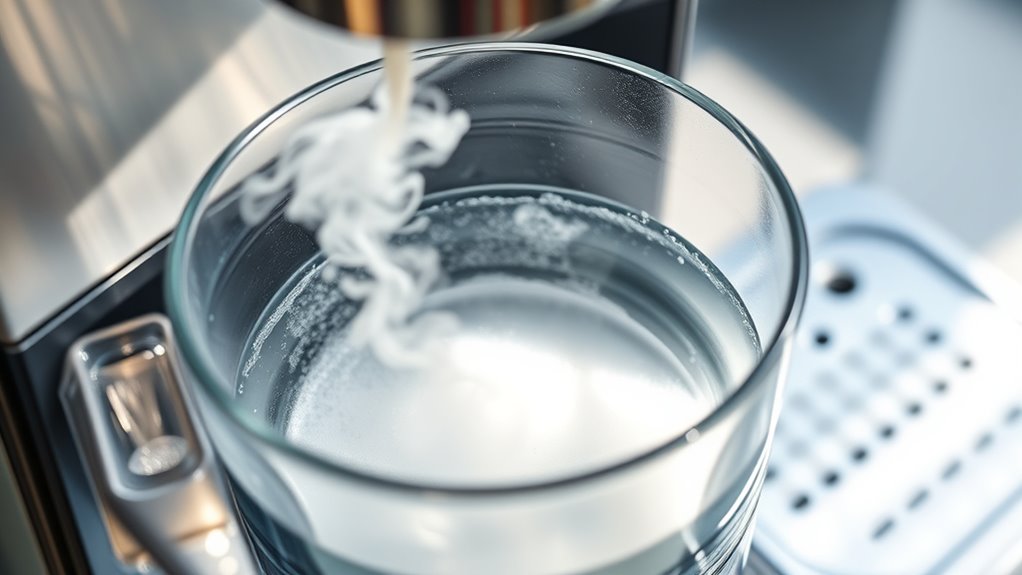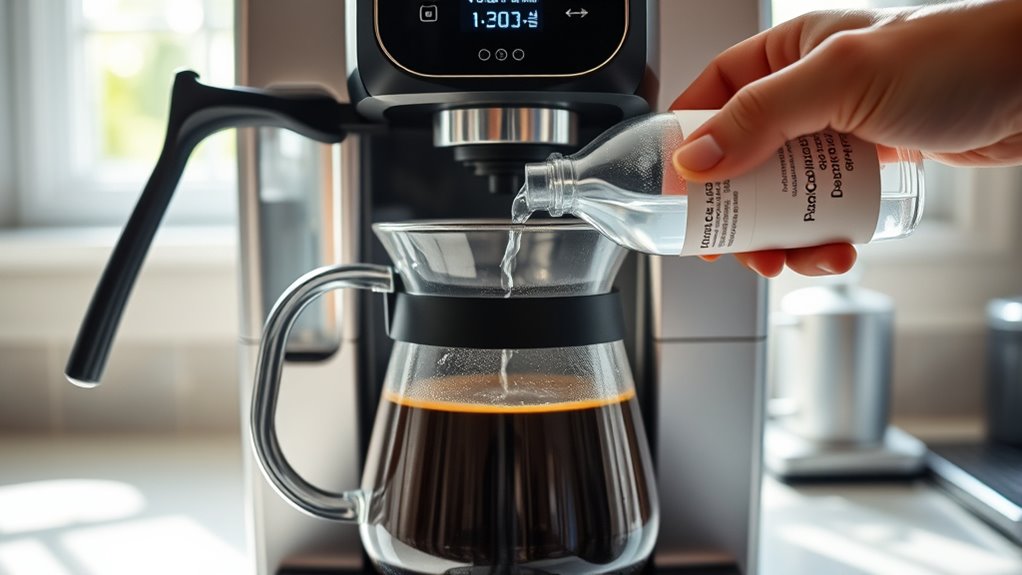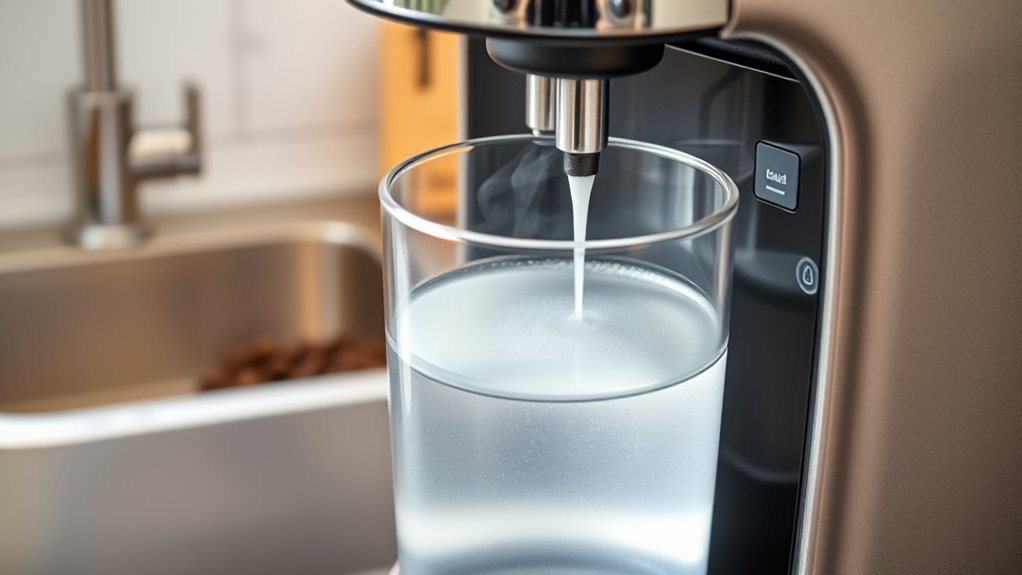To descale your coffee maker the right way, start by filling the water reservoir with a mix of equal parts vinegar and water, then run a brew cycle without coffee. Let it sit for 15 minutes, then run two rinse cycles with plain water. To keep it working smoothly longer, do this every 1-3 months, depending on your water hardness. If you want to know more tips and timing, keep exploring for detailed guidance.
Key Takeaways
- Use a vinegar and water mixture (1:1) to run a brew cycle without coffee for effective descaling.
- Run 1-3 rinse cycles with plain water afterward to remove vinegar residue and mineral deposits.
- Descale your coffee maker every 1 to 3 months, more frequently in hard water areas.
- Regular descaling prevents mineral buildup, improves coffee taste, and extends your machine’s lifespan.
- Maintain your coffee maker by cleaning removable parts and using filtered water to reduce mineral deposits.
Why Descaling Is Important for Your Coffee Maker

Over time, mineral buildup from hard water can clog your coffee maker’s internal components, reducing its efficiency. The quality of your water directly impacts how quickly these deposits form. When minerals like calcium and magnesium accumulate, they hinder water flow and heat transfer, leading to longer brewing times and inconsistent coffee temperature. This buildup can also cause the machine’s heating element to work harder, increasing energy consumption and risking damage. Regular descaling helps remove these deposits, ensuring your coffee maker operates smoothly. Incorporating sound healing science principles by reducing stress and promoting relaxation during maintenance can also extend your appliance’s lifespan. Maintaining good water quality and removing mineral buildup prolongs your appliance’s lifespan and preserves the flavor of your coffee. Ignoring this can result in costly repairs or replacements, making descaling a simple yet essential maintenance step.
Signs That Indicate Your Coffee Maker Needs Descaling

Your coffee maker will give clear signs when it’s time to descale. One common indicator is mineral buildup around the drip area or on the machine’s surface. You might notice a decrease in water flow, resulting in weaker coffee or longer brewing times. Scale formation inside the water reservoir or on the heating element can cause the machine to run less efficiently. If your coffee tastes off or has a metallic or bitter flavor, it’s likely due to mineral deposits. Additionally, strange noises or the machine shutting off prematurely can signal that scale buildup is interfering with its operation. These signs show that mineral deposits are affecting your coffee maker’s performance, making descaling an essential step to restore its proper functioning. Regular descaling can also help prolong the lifespan of your appliance and maintain optimal machine efficiency.
Step-by-Step Guide to Descale Your Coffee Maker

To start descaling your coffee maker, gather the necessary supplies: white vinegar, water, and a clean cloth or sponge. Begin by filling the water reservoir with equal parts white vinegar and water. Run a brew cycle without coffee to allow the vinegar solution to break down mineral deposits and loosen coffee stains caused by water hardness. After the cycle completes, turn off the machine and let the vinegar solution sit for about 15 minutes to dissolve stubborn deposits. Then, run two more rinse cycles with plain water to remove any vinegar residue. Wiping the exterior with a damp cloth or sponge helps remove coffee stains and grime. Regular descaling extends the lifespan of your coffee maker and helps maintain its efficiency. This process helps maintain your coffee maker’s efficiency and prolongs its lifespan.
How Often Should You Descale Your Coffee Maker?

How often you need to descale your coffee maker depends on how frequently you brew and the water quality in your area. If you brew daily and live in an area with hard water, you should descale every 1 to 3 months to maintain ideal coffee quality. Softer water or less frequent brewing allows for longer intervals, around every 3 to 6 months. Regular descaling is essential because mineral buildup can negatively impact the coffee’s flavor and aroma. Additionally, neglecting descaling can reduce your machine’s longevity, leading to costly repairs or replacements. Using proper descaling techniques helps ensure your machine operates smoothly and efficiently. By keeping a consistent schedule, you guarantee your coffee maker functions efficiently, preserves coffee quality, and prolongs its lifespan. Adjust your routine based on your water hardness and brewing habits for the best results.
Tips for Maintaining a Clean and Efficient Coffee Machine

Maintaining a clean and efficient coffee machine requires regular attention and simple practices. Start by using fresh coffee beans, which preserve flavor and prevent buildup. Keep your beans stored in an airtight container away from light and moisture. Guarantee your machine brews at the ideal temperature, usually around 195-205°F, to extract the best flavor and reduce mineral deposits. Regularly clean removable parts like the filter basket and carafe to prevent stale residue. Run a cleaning cycle with vinegar or descaling solution monthly to prevent scale buildup that can impair brewing temperature. Using filtered water helps minimize mineral deposits, maintaining both coffee bean freshness and machine performance. Consistent maintenance ensures your coffee tastes better and your machine stays in top shape longer. Detecting passive voice can help improve clarity and engagement in your writing.
Frequently Asked Questions
Can I Use Vinegar Instead of Commercial Descaling Products?
Yes, you can use vinegar instead of commercial descaling products for DIY cleaning your coffee maker. Vinegar is a natural alternative that effectively breaks down mineral buildup. Just fill the water reservoir with equal parts vinegar and water, run a brew cycle, then follow with plain water to rinse. This method is eco-friendly, affordable, and safe, making it a popular choice for maintaining your coffee maker naturally.
Are There Any Risks of Damaging My Coffee Maker During Descaling?
Think of your coffee maker as a delicate garden; careless descaling can cause machine corrosion or void your warranty. While mild vinegar solutions are safe if used properly, aggressive or frequent use might damage internal parts. To protect your investment, follow manufacturer instructions carefully, avoid harsh chemicals, and don’t overdo it. Proper descaling guarantees your machine stays healthy and your coffee tasting perfect, without risking costly repairs.
How Long Does the Descaling Process Typically Take?
The descaling process usually takes about 20 to 30 minutes, depending on your coffee maker’s model and the severity of mineral buildup. During this descaling duration, you’ll run the solution through the machine, which helps dissolve deposits. The process time is generally straightforward, but it’s best to follow your manufacturer’s instructions to guarantee thorough cleaning without damaging your machine. Patience ensures a clean, well-functioning coffee maker.
Is It Safe to Drink Coffee Made During or Immediately After Descaling?
It’s not safe to drink coffee during or immediately after descaling because of leftover descaling solution, which can affect coffee safety. You should wait until the descaling process is fully complete and you run several plain water cycles to rinse out any residue. Proper descaling timing guarantees your coffee remains safe to drink, and following the manufacturer’s instructions helps prevent any harmful chemicals from lingering.
Can Descaling Improve the Flavor of My Coffee?
Descaling your coffee maker can give your coffee flavor a fresh boost, like hitting the reset button. The benefits of descaling include removing mineral buildup that can cause bitter tastes or weird odors. When your machine’s clean, hot water flows smoothly, extracting richer flavors. So, regular descaling keeps your coffee tasting its best, making each cup a delight rather than a disappointment. Keep your machine happy, and your coffee will thank you!
Conclusion
By descaling your coffee maker regularly, you’ll keep every cup tasting fresh and prevent mineral build-up from turning your mornings into a battle. Think of it as giving your machine a spa day—removing stubborn deposits and restoring its sparkle. Skipping this crucial step is like trying to run a marathon with a weight tied to your ankles. Stay consistent, follow the steps, and enjoy perfectly brewed coffee every time, making each sip worth more than gold.









